Agent Carter is back and, somehow, even more sure of itself after a solid first season. What’s interesting is that the first two episodes of this second season, “The Lady in the Lake” and “A View in the Dark,” offer a flurry of new developments without making it seem as if everything has changed. Nothing feels different, even when everything looks different, and the opening episodes of the second season play with this expectation to devastating effect.
Agent Carter is now a show that’s very aware of its impact, and “The Lady in the Lake” is an exceptionally sleek episode, answering our questions and offering interesting developments with a rapidity bordering on the manipulative. We see Dottie immediately, for example, and it should be enough that she’s alive and capering. And it is, but also she’s now obsessed with Peggy, and Bridget Regan’s mirroring of Hayley Atwell is a treat to behold. She wants to be Peggy, but also she wants to be chased by Peggy, because only Peggy will do. Peggy is life, Peggy is world, Peggy is ALL. Peggy Peggy Peggy. Later on in the episode, silly Jack Thompson tries to fill the void left by Peggy’s transfer to a different plotline, but ends up trapped under a table in about two seconds. The entire sequence borders on the meta, lacking only Dottie uttering the line “This show is titled Agent Carter, Jack.” It’s good to have Dottie back. Also, it’s good to see that she’s evolving into a Joker/Deadpool-style nemesis for Peggy.
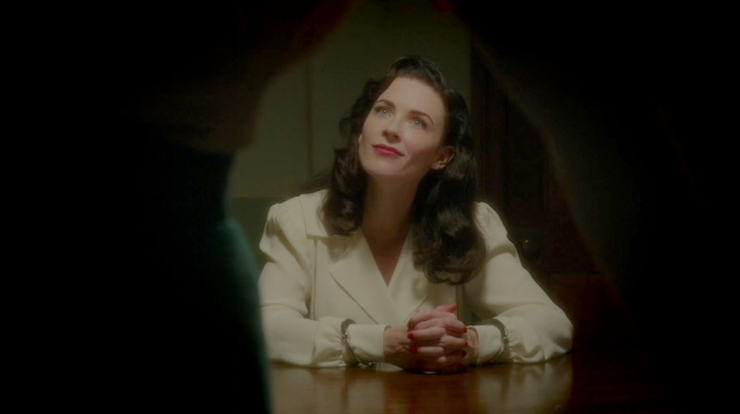
In essentially the same sequence we also find out that the esteem that Peggy earned from the SSR at the end of season one has not gone away. In fact, it has only intensified. Peggy is a sensibly-heeled legend in the bureau now (which tracks well with her eventual founding of S.H.I.E.L.D.). The show could rest on this revelation alone, but it makes an effort to point out that Peggy is just as uncomfortable with adoration as she is with being underestimated. Now Peggy is relied upon to fix everything, and in between moments of Peggy being confident in her obvious greatness, Atwell lets escape terrible and sighs. Even though Peggy has traded obscurity for a pedestal, she’s still considered as an Other, as something separate from the men of the SSR. And she’s still expected to do all the work.
We have a couple more questions about Peggy’s return this season. Namely, what’s up with her and Sousa, and where’s Jarvis? The show wastes no time tackling this, as well. Not only is Sousa now chief of the SSR’s new west coast branch, but he and Peggy Carter attempted a relationship in between seasons! This was a twist I wasn’t expecting, but I adore the producers and showrunners for jumping here. I’m not sure why, but asking why Peggy and Sousa didn’t work out is a far more interesting question than wondering if either will admit to their attraction. Possibly because the first question has a definitive answer, and when we’ve only got eight episodes per season, definition is key.
Sousa and Jack kick off the season by summoning/tricking Peggy into helping Sousa with an investigation in Los Angeles and oh, look, here’s Jarvis to drive her from the airport! He’s been so bored without Peggy that he’s positively bouncing when he first sees her. He wants adventures and procuring flamingos for Howard Stark just isn’t cutting it, even though the flamingo consistently thwarts Jarvis at every turn.
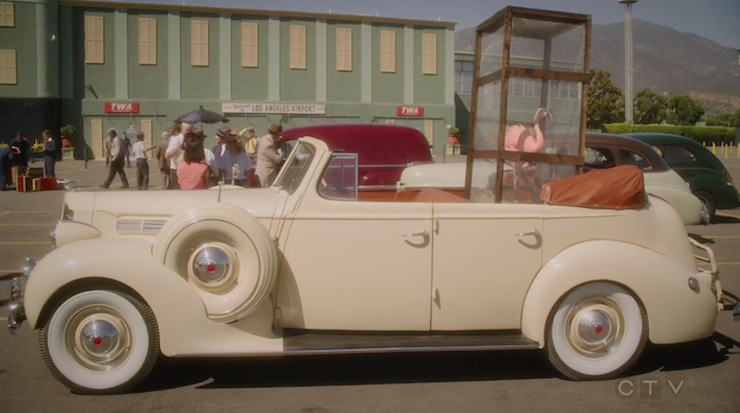
You guys, Jarvis is so great.
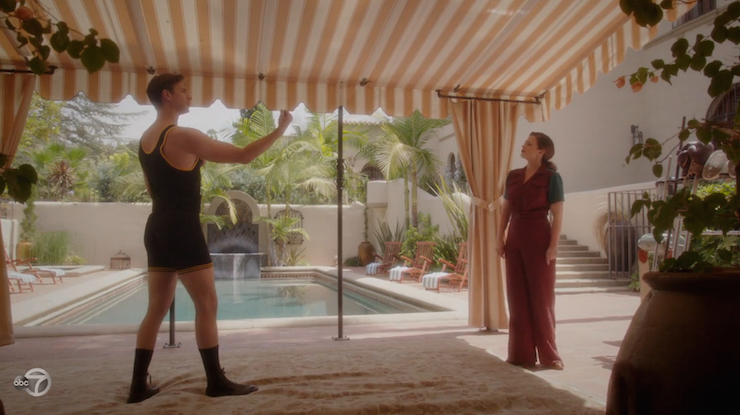
As is his wife Anna, who we finally see and who immediately threatens to steal the show, dubious accent not withstanding.
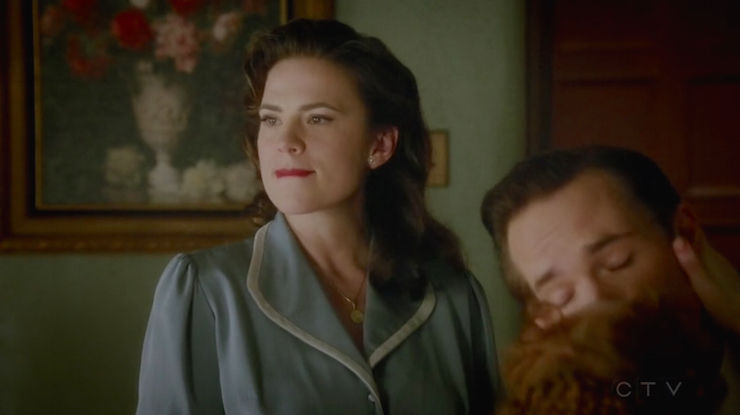
She later makes Peggy a garter holster, just because. Worth stealing a plane for, that one. (Also, look, at the end of “A View in the Dark,” you can see that there’s a statue of a plane on the Jarvis’ sideboard Agent Carter stop feelings I CAN’T.)
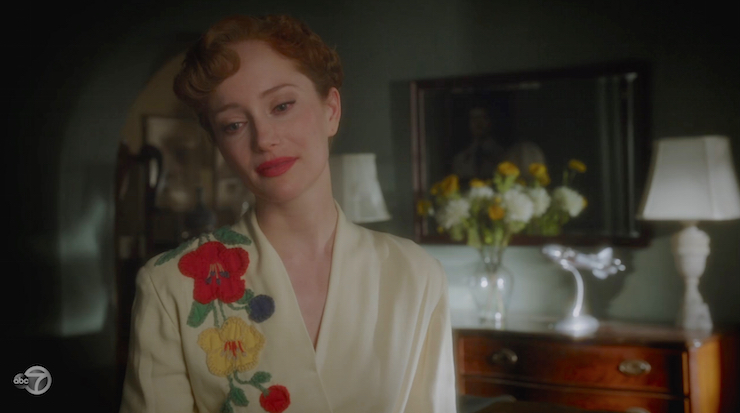
About 25 minutes in “The Lady in the Lake” remembers that as fun as these reunions are, the plot has to kick off at some point. Peggy is asked to come to L.A. because one of its ponds froze over in the middle of a heat wave and also there’s the body of a girl in that ice and oof, the show is pretty light and fun but the visual of the Girl Who Refuses to Thaw is exceptionally disturbing.
We eventually find out that the girl is Jane Scott, a particle physicist at Isodyne Energy who was having an affair with Calvin Chadwick, the president of the company. Chadwick is married to actress Whitney Frost, and at first it seems as if Frost has killed her husband’s mistress with…frost. Especially since Ms. Frost has temper flare-ups from time to time.
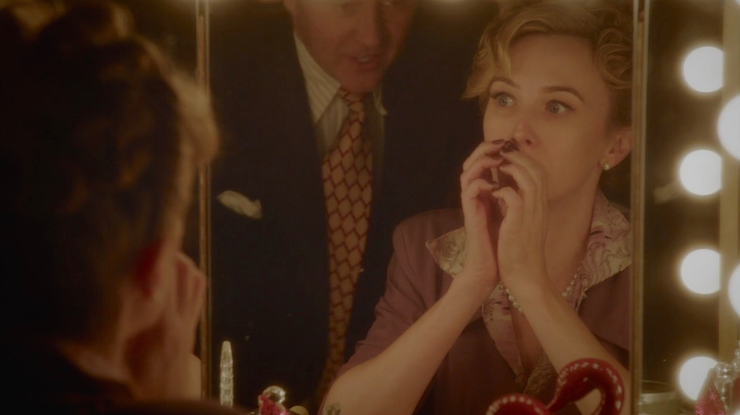
Whitney’s name is just a coincidence, however. It turns out that Isodyne has discovered something they’re calling “zero matter,” a substance which has a seemingly endless capacity for absorbing energy and also, anything.
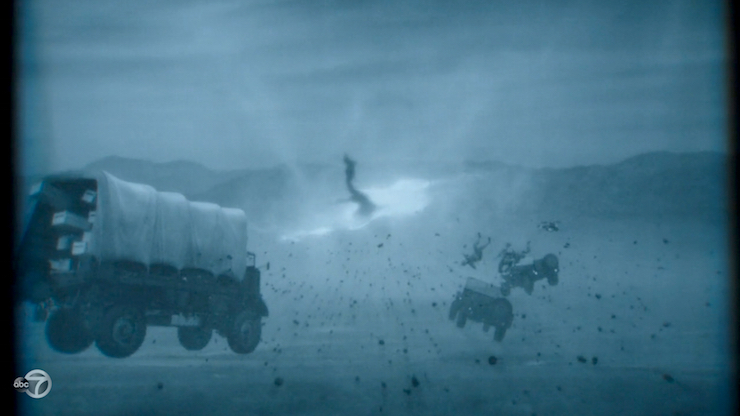
Chadwick is now of interest to a secret cabal of people who love manipulating society to their own ends, which includes scoring free drinks and engineering the Great Depression. We don’t find out much about them. Just that they think zero matter is a dead end, that they wear the same lapel pin that Dottie was trying to steal from a bank early on in the episode, that Ray Wise is one of them, and that they like putting out candles with their hands. I’m just going to call them the Candlestick Cabal from now on.
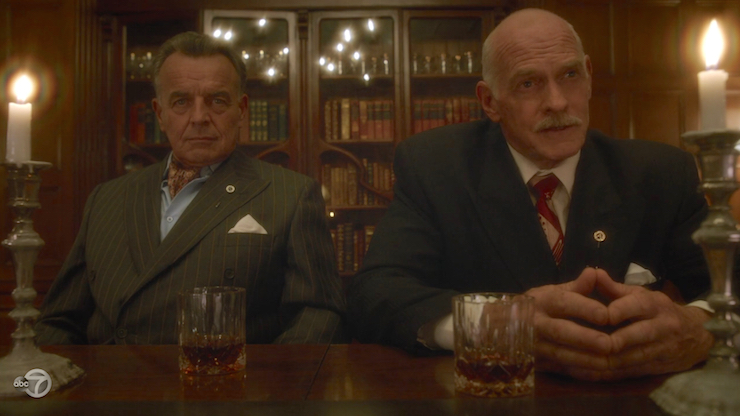
Whitney Frost knows about the zero matter and super duper wants it. (Although her connection to it is yet to be explained.) By the end of “A View in the Dark,” Peggy Carter’s after the zero matter as well, and it’s all thanks to Peggy’s new friend Professor Handsome.
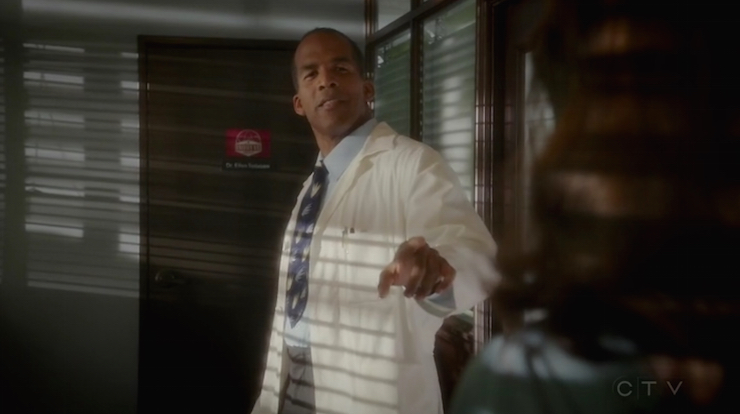
I mean…Jason Wilkes, Plasma Physicist at Isodyne Energy.
Jason is interesting in that he represents an aspect of Agent Carter‘s world that the show is not all that interested in: science. Sure, Peggy and Stark and the rest of the cast have to constantly stop the spread of insane macguffins, but the job of explaining the macguffins (with science!) has always been portrayed by lab-coated bumblers. The show hangs a lampshade on this in “The Lady in the Lake,” when an SSR scientist reallllllly extends his scene by pouting that he’s never included in the SSR’s office functions, but other than that scene, Agent Carter‘s second season still seemingly pushes the scientists to the background.
Wilkes seems as if he may change this, but his story is actually more about his place in the world than it is about the work that he’s doing. It’s a fascinating thwarting of expectation for the viewer. We assume that we’ll learn more about zero matter and otherworldly realms, but instead Agent Carter uses Wilkes to explore the different ways that Peggy and Jason experience the same world.
Issues of race didn’t come up at all in the first season, but they’re the strongest part of the second season episode “A View in the Dark.” The plot itself is perfunctory. There’s a bad macguffin, Peggy’s gotta get it, the bad guys chase her, etc. In between that, though, is Peggy and Jason going on a date, relating their histories to one another, and encountering the various everyday barriers created by those who judge Jason based on the color of his skin. Although it is brief, for a moment Jason gets Peggy to understand how racial inequality supports and encourages the world-shattering evil that she is trying to stop. Jason wants to help Peggy, but Isodyne is literally the only place that will employ him. No other company will hire a black scientist. Morally, his loyalty is to Peggy. Realistically, his loyalty has to be to the only company that will give him work. This is how the Candlestick Cabal-joining Chadwick uses racial inequality to do harm, by placing good people like Wilkes into positions between him and the authorities.
Peggy seems to realize this, and becomes positively murderous at the very next person (a donut salesman) who treats Wilkes like something lesser. Peggy not only knows her own value, she is adept at judging the intrinsic value of others. Jason Wilkes clearly lives up to Peggy’s high standards, and for a brief moment, Peggy allows herself to find comfort, to be attracted, to someone else.

The first two episodes of Agent Carter‘s second season expertly blends reunions and updates on the established characters, while pushing them swiftly into new developments. It comes as a shock, then, when Wilkes is seemingly killed at the end of “A View in the Dark.” Not only because his character is featured so heavily in the new season, but because it puts Peggy right back where she was at the end of Captain America: The First Avenger. Steve Rogers died shortly after Peggy admitted her feelings and finally kissed him. And Wilkes dies in very much the same manner.
This parallel scrambles Peggy, who was already having some difficulty adjusting to the adoration and trust she receives from the SSR. Steve is gone, the SSR relies on her. Even psychopaths like Dottie want to be her. Shouldn’t things be different now?
Thoughts:
- Back in New York, Kurtwood Smith is telling Drinkin’ Jack Thompson that the FBI will be dissolving the SSR. It sounds like Peggy may not have a job by the end of the season. Though we all know how she fixes that particular problem.
- “Don’t Fence Me In” was a mainstream hit of Roy Rogers’ in 1944, so much so that a cover of his cover was a hit in 1945. Its presence on Jarvis’ radio in 1947 seems quite appropriate. I wonder if the presence of the Roy Rogers version over Cole Porter or Ella Fitzgerald’s versions of the song is foreshadowing of Wilkes’ storyline?
- Peggy sneaks in a VERY unflattering comment about Howard Stark during the drive from the airport. Jarvis likens Stark to Cecil B. DeMille, a famous silent filmmaker turned industrialist, while Peggy likens Stark to Fatty Arbuckle, a silent film star who…had his life destroyed by being falsely and publicly accused of rape in the 1920s. (His films remain largely destroyed as a result.)
- Anna Jarvis shares her name with Anna Jarvis, the woman credited with inventing Mother’s Day. The real Anna Jarvis would still exist in the 1947 time frame of Agent Carter‘s second season, and judging from her biography linked above, the real Anna Jarvis could very much use rescuing.
- Zero matter acts a lot like Ice9 from Kurt Vonnegut’s Cat’s Cradle, published in 1963. If the show manages to sneak in a young Vonnegut being inspired by the events of this season, I will die.
- How does the only white guy in the bar in “A View in the Dark” escape Peggy’s notice?
- What:

Chris Lough writes about fantasy and superheroes for Tor.com and is Team Dottie 2016. He has a website, okay.










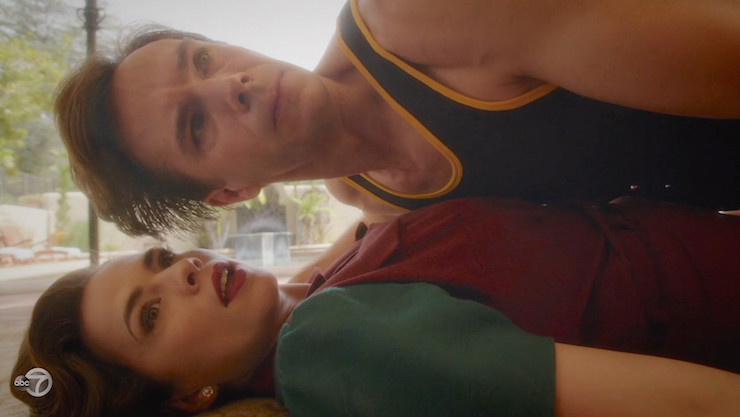
Note that “Whitney Frost” is actually the secret identity of Madame Masque, a long-time IRON MAN villain.
I’m so glad you highlighted Dottie’s smirk. Compare it to her beauteous smile at Peggy.
Now compare it to Violet’s smile at Sousa. She’s a Widow, I’m calling it now.
he and Peggy Carter attempted a relationship in between seasons
When was this confirmed? I got the impression she never asked him for that drink, then he left and she missed him. When Thompson sends Peggy to LA because he’s jealous, he lies and says Sousa ASKED for her. So Peggy got excited that NOW she could have that drink and see where things went, only to learn that Sousa was dating, because he moved on. Did I miss something? The whole discussion was Rose, because Rose knew he pined over her, because Rose is the legit best, and surfs, so THERE.
Also, I we have 10 episodes this time.
I enjoy the people that STILL find their useless talent agency. So meta.
I’m pretty sure Wilkes is alive, we saw Frost. I hope that she’s using him to hold the zero matter
SPOILERS roll over
The showrunners deny the A logo is related to HYDRA/Maveth worshippers from AoS, likening them to the Secret Empire
Zero matter will eventually lead to DarkForce, seen in AoS and soon to be in Doctor Strange.
Wilkes is alive and will be impacted by the changes done to him by the zero matter, as will Frost.
@@@@@ 2 Aeryl There was a few lines about calling back and forth coast to coast. And that the few hour delay made it feel much greater on Sousa. Sounds like they started seeing each other, when Sousa got the west coast Chief position they tried long distance, but it didn’t work. They moved on.
I thought that was FBI!Red Forman paying off the LAPD officer at the end of Part 1 until Ms. Frost sat up. (And who else knew the ‘accidental’ shooting was on purpose?)
I knew Whitney Frost sounded familiar. But I did not know AC was back! Color me happy.
@2: I came away with the same impression as you in regards to Peggy and Sousa’s relationship. At the most, I think they had drinks together and it wasn’t unambiguously a date, or they had plans to do so – very tentative steps towards a relationship beyond being colleagues – and then Sousa moved away. That’s the explanation that makes the most sense of what was said and their behaviour towards each other in these eps… I guess there was enough left unsaid that there could turn out to have been something more, but for now I’m assuming that the answer to Why didn’t Peggy and Sousa’s relationship work out? is “because it hasn’t had a chance to exist yet”.
@2 I didn’t catch anything about an attempted relationship either–the way I took it, there was just a lot of unrequited feelings between them.
I thought it was a good, solid start to the new season. I liked the fact that the gatekeeper from the telephone company is now at the front desk of the talent agency–one of those nice, secondary characters that makes this fictional world all that much richer. I very much like Anna Jarvis, although her accent didn’t ring true to me. Jarvis was great as usual. I liked Doctor Wilkes, but am not mourning him yet–since this a comic book story, and we didn’t see a body, I suspect that he may not be gone yet.
Regarding Peggy and her romantic life, I think we will know who her true love is when he mentions that Cap saved his unit in WWII, which will tie things into statements made in the movies.
Due to the events of last season, I watched the show suspecting literally EVERY WOMAN but Peggy to be a Black Widow. Sousa’s girlfriend in particular, since his is a Marvel production, and she is suspiciously too understanding and patient for some not named Mary Jane…
No comments on the plot lines this season since it’s just started.
But there seems to be a theme involving preconceptions and prejudice. The most obvious was with Wilkes, both in his story and how he was treated at the convenience store.
But it was also there in the way Sousa was surprised that lab tech Samberly? wanted to be included when the office went out for drinks (ironic because Sousa had experienced being excluded when back in New York). And it was expressed by Peg and Mrs Jarvis when they spoke about what they expected the other to be like. (By the way, I LOVE Mrs. Jarvis.)
And I feel sorry for Thompson. Yes it’s because of his own insecurities that he sends Peggy off. But I think it’s also because he wants to prove himself. So first he’s overpowered and dismissed by Dottie who only has any respect for Peggy. Then the FBI takes over the case and he is told his current job is redundant, that he got into the SSR in the first place as a favour and that a new appropriate position would be found that befits his ‘pretty face’. Not great for his self-esteem.
I really liked the start. Dottie basing her existence on Peggy makes so much sense – she gets to defame the SSR by matching their style and also fixates on the one person to defeat her.
Dr Wilkes was far far too handsome not to be a bad guy. None of us trusted him at all. Also we’re leaning towards the nurse being a Russian spy. Conservation of characters and all that. I wonder now though if Dr Wilkes turns into a version of Cloak.
We’re pretty sure the Zero Matter will tie into the missing two Infinity Stones. If it turns out to be the Darkforce and end up in Doctor Strange as well, it pretty much has to fit in somehow.
Great opener to a great series.
Add me to the list of folks who didn’t read into things so deeply that Sousa and Carter had tried a relationship. We’ll see, perhaps, but I didn’t get the sense of a failed relationship so much as one that never got off the ground.
Dottie/Peggy did have a very Joker/Batman feel during the interrogation.
Totally thinking the nurse is another Black Widow. Initially thought Whitney Frost was, as well (“What’s better than one Black Widow? Two Black Widows!”) but after learning that is the name of Madame Masque, not so much.
Was really wanting Kurtwood Smith to tell Thompson to stop being a dumbass.
I know everyone is saying that Zero Matter will eventually lead to the Darkforce but it sure does act a LOT like Gravitonium from the Agents of S.H.I.E.L.D. Season 1 episode titled “The Asset.” (I had forgotten, until I re-read this review, that AoS had a guy named Mack in Season 1. And the guy drove a truck. I see what you did there, AoS.
Since I read io9’s recap before I watched the episodes yesterday, I was looking for other white folks in the club scene. There’s a white couple dancing over Peggy’s shoulder while she and Wilkes are on the dance floor. Also, Sousa mentions that he and his girlfriend went there to see Ella Fitzgerald, so clearly the club caters to a mixed-race crowd, whether we actually see white folks in frame or not. On that basis, I don’t find it odd that neither of them took note of Assassin Guy.
Really just commenting to say how happy I am that the show is finally back–Peggy is a much-needed, completely delightful ray of sunshine in the midst of a particularly bleak January, so far :) And don’t even get me started on how great it is to see Jarvis and Dottie again (I’m assuming Dottie is sticking around, right? Because she’s quickly becoming one of my favorite TV villains of all time–Bridget Regan’s ability to shift between smirky-and-calculating to sheer psychotic glee and back without actively being hammy or cartoonish…not sure that will ever get old.)
Plus Anna Jarvis is being played by Lotte Verbeek, who played a sassy time-traveling witch on Outlander for a bit, so I’m going to go ahead and mash those roles together in my head canon… And hooray for Ray Wise, alway; if the Crusty Order of Lapel Pin-Loving Candle Snuffers ever disbands, at least he and his stock market-crashing crony can always fall back on playing the Duke brothers in an all-but-inevitable remake of Trading Places one of these days… In any case, thanks for recapping again, Chris! Let’s hope the show starts earning the audience it deserves this season…
I find it extremely unlikely that the nurse is a Black Widow.
When you think about it, there cannot be a lot of black widows, especially since part of the training is killing each other. So any black widow would be placed where she could do the most bad. Unlikely to be a nurse and Sousa is not important enough to be of interest long term, especially since the ‘other side’ is probably aware that the SSR is going to be phased out.
It’s more likely that the dead girl was a black widow. Isodyne would definitely be of interest to the Russians and Dottie was trying to steal a lapel pin from the group that Chadwick is a part of. (Yes, she ended up dead, but Whitney Frost seems badass enough even to take on a black widow.)
Ana Jarvis is also more of a possibility since she is in a position to keep an eye on Howard Stark, who would definitely be of interest. But I really hope she’s not.
Given the Whitney Frost connection and the “1940s gang of powerful men behind Hollywood crime” a la the Mafia, I’m holding out hope that the Candlestick Cabal actually turns out to be the Maggia (one of those wonderfully slightly-off-kilter Marvel ideas one never quite sees enough).
Although, really, all I want is more of Peggy and Dottie-as-Peggy fighting in bank vaults. That scene was basically F.A. Hayek’s “Dear Penthouse Magazine, I can’t believe it happened to me…”
Am I the only person on two sites who actually saw Wilkes run out before the explosion? He was a step behind Frost (which explains why Peggy didn’t encounter him; he went out the same alternate door Frost used to enter).
Peggy is back! Squee!
While these episodes felt like mostly set-up for later, the details continue to be great. Much like Peggy.
@11 Was really wanting Kurtwood Smith to tell Thompson to stop being a dumbass.
Hah — me too! I saw his name in the opening credits and laughed.
I also read the Peggy-Sousa dynamic as a never-quite-got-started relationship, instead of a failed one. It sounds like Sousa got moved to CA soon after the end of season 1’s events, and he and Peggy wanted to keep in touch, but starting a relationship long-distance is hard. Especially when Princess Aurora from Once Upon a Time attractive Nurse Violet is around to be sweet.
I think this Whitney Frost, like many characters in the Marvel TV universe, will only have a passing resemblance to the comic book character. So far, the socialite with criminal connections somewhat matches the comic. And with that blotch of zero matter on her face, I wouldn’t be surprised that a mask of some sort is in her future (along with the name of Madam Masque). But other than that, her story could go in a lot of different directions.
While I know Bolger played Aurora on OUAT, she was more recently seen in AMC’s Into The Badlands, where she was pretty diabolical.
Luckily for Wilkes (assuming he survived somehow) losing his job is not that much of an issue because Peggy has the connections to get him a choice of two jobs – working for the SSR/SHIELD science division or working with her uber rich scientist friend Howard. Let’s face it, the SSR really need some smarter tech guys though.
@20
It’s 1947. What idiot would consider hosting a tech industry in California?
Place is nothing but sand and surf, with a bit of Hollywood glamour ;)
Oh, and mobsters. Lots of mob activity at the time, especially with Bugsy and the development of Las Vegas. Be interesting to see how much of that shows up.
@21 Well, California is relatively handy for the Nevada bomb test sites, and a lot of nuclear work was done out of Berkeley, for a tech company building weapons it makes some sense.
In our house we were wondering how they created the zero matter in the first place, was it an accident, or did someone add something to the bomb?
Really enjoyed this return. And it’s great to see how the showrunners responded to the complaints about representation in S1. Anna Jarvis is a delight, and it’s great to see Peggy have a female friend who knows about the spy stuff.
I’m trying not to see Black Widows everywhere, but I suspect there’s a fridge with the nurse’s name on it.
Meanwhile, I don’t trust FBI guy at all. I’m wondering if they’re setting up that HYDRA will use Thompson to infiltrate SHIELD from the beginning.
The movie Whitney Frost was filming is called The Woman with the Golden Face, in a nice nod to her comics version.
Apparently the club Carter and Wilkes went to is a real place — still around, I think — that was known as one of the few places where the races could mix, and even that pairing could go unnoticed (except for being so extraordinarily good-looking. And I appreciated that racism was discussed appropriately, but the show didn’t bludgeon us with the obvious.
Love the clothes, love the scenery and the brighter palette they’re using for L.A.
@22 In the years following WWII, in addition to pursuing the H-Bomb, researchers were looking at all sorts of ways to enhance the yields of the existing weapons. I remember when I was cutting my teeth on SF back in the 60’s, Analog Magazine was full of stories about various types of atomic bombs, and their potential impacts, up to and including igniting the entire atmosphere of the planet. At one point, there were a even number of stories about implosion bombs. This marks the second season of Agent Carter that involved some sort of implosion bomb as a MacGuffin. The science on the show may be pseudo-, but it is at least true to some of the SF stories of that era.
@23 I agree, that FBI guy was giving out strong Hydra-type vibes.
Having missed most of the last round of AoS, how confused am I likely to be if it’s this Darkforce thing?
I love the fact that both Ana and Violet are framed as if we are about to get a ‘Peggy is jealous of X’ or ‘X is jealous of Peggy’ set up, because of her relationships with the men in their lives. And in BOTH cases the women are friendly, helpful and genuinely pleased to meet Agent Carter.
It’s just so damned refreshing to have narratives where the women trust the men in their lives (Violet has some reason to be a bit less trusting, but still) and don’t immediately assume that other women are a threat to them. The Ana-Jarvis-Peggy scenes were adorable because Ana is clearly secure in her relationship, and Jarvis is clearly not romantically interested in Peggy. But Peggy’s reaction shows that she is expecting a slap rather than a hug of friendship… and is delighted to find that Ana and Violet are so accepting of her.
I’ve long been wondering what kind of woman could put up with the strain that Howard Stark’s employment would clearly put on a marriage, and the answer is: one with a sense of humour!
Also I thought Ana’s accent worked fine – it sounds very much like someone who has been working to rid herself of the more obvious German strains of her original accent, which makes a lot of sense for someone who has been living in America for several years during and after the war.
@noblehunter, Darkforce actually showed up back in Season One, the Amy Acker episode, the cellist who had a stalker. The power he had was Darkforce. It’s also suspected that the Zero Matter may also be Gravitonium, from Season One. It was last seen in Quinn’s possession as he fled his momentary alliance with Garret with Raina. So they could be planning to bring it back in that state, after reintroducing it via Agent Carter.
@TansyRR I really hope we learn that Ana has a job of some sorts. I seem to recall Verbeek is only scheduled for a few episodes(they better not kill her), so her also having a job working for Stark in some proto-Pepper would be neat. She could just be taking a few days off to make Peggy feel welcome, before going back to running Howard’s appointment book.
I enjoyed these two episodes, although there were some times when I thought the writing was a bit on the nose – on the other hand, there were enough refreshing and interesting moments.
Kudos to the show for making the new villains intriguing, and even somewhat sympathetic, from the start. I found myself feeling for Whitney Frost, with the way she has to deal with the society valuing her just for her looks and who she is married to, rather than her intelligence, and having to deal with the Hollywood ageism (especially as she doesn’t seem to isn’t particularly “old” and her co-star looked considerably older, but no one said anything about him). Her marriage to Calvin Chadwick definitely isn’t a conventional marriage, it’s more like a partnership. I wonder if the two of them are even having sex. I’m not sure if she has any genuine affection for him or if she just needed that marriage, but as much as he ticks all the boxes of in the “sleazy, corrupt politician” profile, he seems to not only respect but really love her in his own way, although he’s sleeping around, with her apparent approval.
Dottie has also become more interesting since she’s developed her obsession with Peggy and with being like Peggy. Hayley Atwell has compared it to Single White Female, but it also makes me think of Faith after turning evil on Buffy in seasons 3 and 4. A black widow must be a rather damaged person with issues with identity, it’s not that surprising she feels jealousy and fascination with someone like Peggy. (Also, Bridget Regan looks much better with dark hair.)
So are people going to be shipping Thompson and Kurtwood Smith’s character after the “pretty face” comment? ;) Just kidding. But I’ve seen people ship/speculate stranger things… (like Peggy/Thompson… I really don’t get that one.)
@2: That’s exactly how I saw the Peggy/Sousa situation. I don’t know where people are reading the “failed relationship” stuff. It was clear in season 1 that he thought he could never have a shot with her because of his own insecurities and because she used to date Captain America (not knowing she knew and was interested in Steve Rogers when he was a skinny, small and sickly). When Peggy asked for a rain check on their drink, he took it as a rejection, while Peggy was smiling and thinking: “Maybe this is something to hope and try in the future” when she gets over Steve and is ready for another relationship. Plus, she clearly told Anna that it has been a loong time since she had a relationship. (And even her relationship with Steve never got to the physical stage other than a kiss, so… damn, it must be a long time!)
That said, I have to say the Peggy/Sousa romantic subplot was the weakest part of the episodes for me. It’s blatantly obvious that he’s being set up to be the husband she talks about in the 1950s footage in Winter Soldier. I thought that was probably where they were going in season 1, but now it’s way more obvious. And I’ve always been fine with that, Sousa was likable enough in season 1, and it would be a nice relationship… but I just never got too enthusiastic about it. They are obviously trying hard to make the viewers root for them, but I’m just kind of… not caring that much? Maybe because it feels so telegraphed. I’ve never found the “who’s going to be Peggy’s husband?” question all that compelling on this show, there are so many other, more interesting things going on, and frankly, Peggy has much more interesting relationships with some of the people she definitely won’t marry.
But god, I hope Violet is not really a black widow (which doesn’t even make a lot of sense, as pointed out above) or otherwise a villain, because that would be such a cop out and cheap plot device, used in every romcom out there. “Out heroine’s potential love interest has a serious girlfriend/fiancee, let’s make her evil!” Ugh. I hope the show is better than that. The only refreshing and original thing about the Peggy/Sousa stuff is that Violet is really nice and gets along with Peggy. I hate the “All Women are Catty” *and fight over men) trope, and it’s good to see the show subvert it.
It was similarly great to see Anna portrayed the way she was and become Peggy’s friend. It’s funny how the show deliberately puts Peggy and Jarvis in those situations that would regularly scream “sexual tension OMG!!!!” but here they just underscore how much they don’t have any sexual tension, which is a really refreshing take on a male/female dynamic.
At the moment, Peggy’s relationship with Jason Wilkes adds some fun and promises to be more interesting than I find Peggy/Sousa, though a lot of depends on how they develop his character and their dynamic. His introduction allows the show to explore the racial issues (and I hope there’s more of that, because it would be hardly realistic if everyone was OK with Peggy and him dating in 1947!), but I like the fact that he’s not defined just by being African American. Like she said, he is quirky, charming, a genius… but unlike Peggy, I wouldn’t trust him immediately. (You have to make some moral compromises to get ahead when so much is stacked against you, and he’s really charming… and while he was telling Peggy about his background, I couldn’t help thinking of Howard telling Peggy in season 1 that getting ahead in spite of the boundaries set by the society requires being able to lie and manipulate.) On the other hand, I don’t want him to be a bad guy, either. It would be most interesting if they portrayed him with some moral ambiguity. Maybe he was a perfectly nice guy so far, but who knows how the Zero Matter will affect him? We’ll see.
On another note: that Fatty Arbuckle comment was wrong on multiple levels. On one hand, Peggy using the unfortunate Arbuckle as shorthand for “sexual depravity”, which was clearly what she was aiming for, is wrong because, by all accounts, he wasn’t “depraved” and was falsely accused and condemned by the public even after having been acquitted. On the other hand, if Peggy assumes that Arbuckle was guilty of what he was accused of – which was rape and manslaughter – it’s really wrong to compare him to Howard, who, no matter how much Peggy is disgusted by his womanizing sex addict* ways, isn’t doing anything other than having consensual sex with adults.
* That’s what he is, isn’t it? Naturally, I don’t expect them to have that concept in-universe in the 1940s, but that’s exactly how they’re writing him on the show. I can’t say I have any first hand knowledge on the subject, but Howard’s sexual behavior as seen and described on the show goes beyond standard “womanizing” and seems to match textbook descriptions of sexual addiction, especially with the fact that he never seems to have any real romantic relationships, and shows no sexual interest in the (apparently) only woman he cares about/has an actual emotional connection to.
Deadpool? What’s Deadpool about Dottie?
And I can’t help being suspicious of Sousa’s girlfriend…
I think Jack Thompson will be offered to stand-in for Captain America, and that any drugs or treatments he gets for that will only make his issues worse… don’t they mention he had anger issues or was “aimlesS” after the wars?. Plus, his new position wil befit his “pretty face”?
I thought/think Wilkes would eventually (not in Agent Carter) become the Blue Marvel, despite the different name. I know his powers have nothing to do with darkforce, but still…
On another front, I do appreciate that Anna Jarvis does not see Peggy as a threat to her marriage, and is a friend to her.
Someone give the actress who plays Rose the role of Etta Candy.
@@.-@ – sps49: The “accidental” shooting was very obvious.
@10 – Mayhem – Cloak? Hmm…
@22 – phuzz: I believe the bomb was tested in a place where there was already a slight crack between dimensions, and it was widened by the explosion.
@26 – TansyRR: Yes. All that.
I’m concerned that no new content has appeared on the Tor front page since 01/21/16. Is it just me or have I missed something? I’m asking on this thread because it has the latest comments. Thanks.
It’s just you. Must be a settings issue on your puter.
Try deleting your browser’s caché (or getting someone to do it for you); or before that, do ALT+F5 or CTRL+F5 (depending on what browser you’re using, and I have no idea if you’re using a Mac or any device that’s not a PC) to do a hard refresh on the front page.